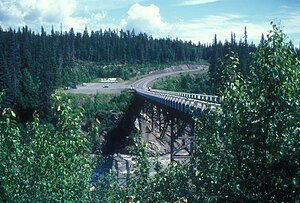Nass River
The English name "Nass" is derived from the Tlingit name Naas which means "intestines" or "guts" in reference to the river's large food capacity in its fish (Naish & Story 1963; Leer, Hitch, & Ritter 2001). Can also be a Tlingit word for "food depot". Former spellings are Naas and Nasse. The Nisga'a name for the river is K'alii Aksim Lisims "Lisims (river name) Valley". The Gitxsan name is Git-Txaemsim meaning People of Txeemsim (Raven or Trickster); Xsitxemsem in the dialect of the Gitanyow). Lisims means "murky" in Nisga'a, referring to the river's silt-laden flow.
The last 40 km (25 mi) of the river are navigable. The river is a commercially valuable salmon fishery. The basin of the Nass is the location of the first modern-day treaty settlement in British Columbia, between the government of that province and the Nisga'a Nation. The name Nisga'a is a reduced form of [naːsqaʔ], which is a loan from Tongass Tlingit, where it means "people of the Nass River".
On the term:
Archdeacon W. H. Collison, an authority on this subject, and who has resided at Kincolith, Nass bay, since 1883, states as follows: - "The term Nass is from the Tlingit tongue, and when, as was probable, the Tlingits from Tongass, at the entrance to Observatory inlet, met Captain Vancouver they gave him their name for the river, i.e., Nass, which means literally "the stomach," from the fact that their food supplies of salmon, oolachan.. a noted fishery."
History

About 220 years ago, as recorded by the oral history of the Nisga'a people, the Nass River was dammed by a 22.5 km (14.0 mi) long lava flow which came from the Tseax Cone and destroyed the Nisga'a villages and caused the death of at least 2000 Nisga'a people by volcanic gas and poisonous smoke. The volcano has been active on at least two occasions (220 and 650 years ago) in the last millennium. Because of our knowledge of this previous disaster, modern monitoring techniques should include studies of the gases emitted by the volcanoes and the institution of a warning system to alert people living down slope from the volcanoes.
Hazards
If the Tseax Cone were to erupt again, there could be a repeat of the poisonous gas disaster that happened to the Nisga'a people 220 years ago. The eruption could also cause forest fires and could potentially dam local rivers such as the Nass River and the Tseax if the volume of the lava flows are large enough. If the lava flows were to again reach the Nass River, it could have disastrous short-term consequences for the important salmon fisheries on the Nass River system.
Tributaries
This is an incomplete list of tributaries, in upriver order:
- Xnukw (Iknouk River)
- Ksi Hlginx (Ishkheenickh River)
- Ksi Sii Aks (Tseax River)
- Ksi Gwinhat'al (Kwinatahl River)
- Tchitin River
- Kinskuch River
- Cranberry River
- White River
- Meziadin River, Meziadin Lake
- Bell-Irving River
- Kwinageese River
- Taylor River
See also
References
- ^ "Nass Lake". BC Geographical Names.
- ^ Elevation derived from ASTER Global Digital Elevation Model, using GeoLocator, and BCGNIS coordinates.
- ^ "Nass River". BC Geographical Names.
- ^ Nass River Archived 2005-05-07 at the Wayback Machine, The Columbia Gazetteer of North America
- ^ Gazetteer of Canada. Vol. British Columbia. Canadian Board on Geographic Names. 1953. p. xv.
- ^ Normal Runoff from British Columbia, Ministry of Environment, Water Stewardship Division
- ^ "Bay Point". BC Geographical Names.
- ^ "Nass Point". BC Geographical Names.
- ^ Hamilton, William (1978). The Macmillan Book of Canadian Place Names. Toronto: Macmillan. p. 46. ISBN 0-7715-9754-1.
- ^ Rigsby, Bruce "Nisga'a Etymology", ms. University of Queensland.
- ^ Walbran, John T. (1909). British Columbia Coast Names, 1592-1906, to which are Added a Few Names in Adjacent United States Territory: Their Origin and History. Government printing bureau. p. 352.